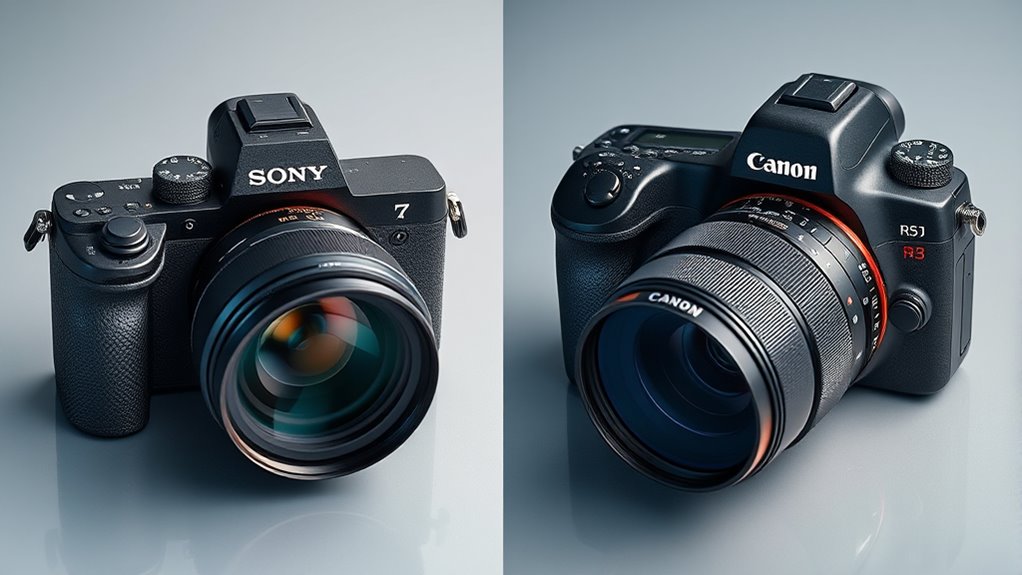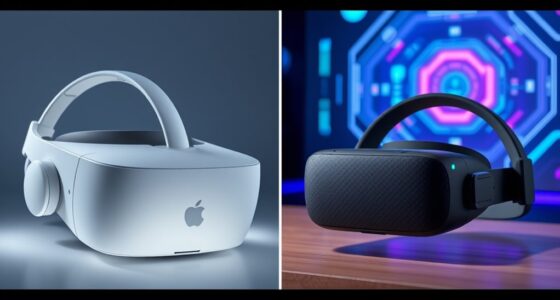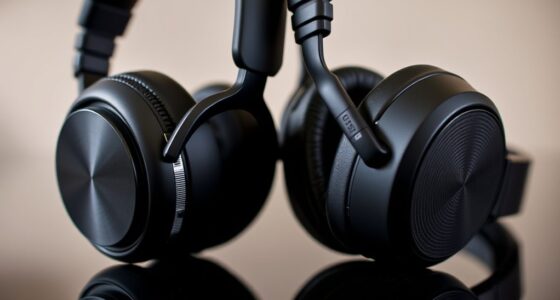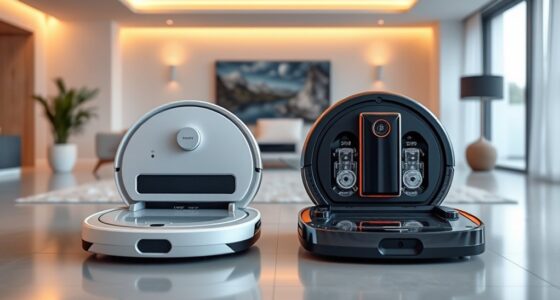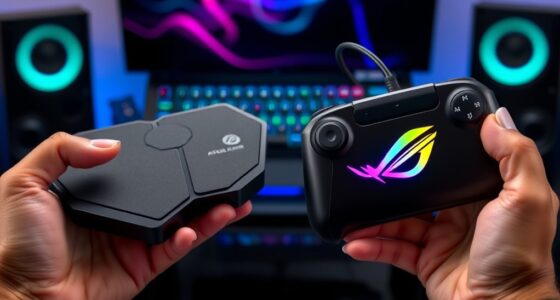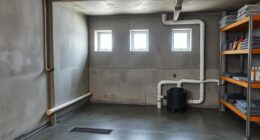If you’re choosing between the Sony A7R V and Canon R5 II, consider what matters most to you. The Sony offers incredible resolution, superior high ISO performance, and a lighter design perfect for detailed photography and cropping. The Canon excels in autofocus, rapid burst shooting, and advanced video features, making it ideal for hybrid shooters or videographers. To discover which camera best fits your needs and see detailed comparisons, continue exploring the key differences.
Key Takeaways
- Sony A7R V offers higher resolution with a 61MP sensor, ideal for detailed large prints and cropping, while Canon R5 II balances resolution and moiré control.
- Canon R5 II excels in faster autofocus (5,850 points) and higher burst speeds (20 fps), making it better for action and wildlife photography.
- Canon provides superior video capabilities with 8K at 60 fps and longer recording times, appealing to hybrid shooters and videographers.
- Sony’s higher ISO performance and lighter, more portable design benefit outdoor, long-duration, and high-resolution work.
- Canon’s ergonomic build, fully articulating screen, and advanced stabilization favor usability and versatile shooting scenarios.
Sensor and Image Quality Comparison

When comparing the sensor and image quality of the Sony A7R V and Canon R5 II, you’ll notice that Sony’s 61-megapixel BSI CMOS sensor delivers higher resolution and greater detail potential, making it ideal for large prints and cropping. Sony’s sensor lacks a low pass filter, which helps preserve fine details but can increase moiré risk. Its smaller pixel size (3.76µ) allows for more pixels on the sensor, boosting resolution, though it may affect noise performance at high ISO levels. In contrast, Canon’s 45-megapixel stacked CMOS sensor includes a low pass filter, reducing moiré but slightly limiting detail. Canon’s larger 4.39µ pixels gather more light per pixel, enhancing low-light performance and signal-to-noise ratio. Overall, Sony offers superior dynamic range and resolution, while Canon balances detail with moiré control. Additionally, the choice between the two may also depend on the sensor design and how it influences overall image rendering. Moreover, the sensor architecture can impact color accuracy and tonal gradation, which are critical factors for professional photographers. A deeper understanding of sensor technology can help users select a camera that best suits their specific needs and shooting conditions. Furthermore, sensor manufacturing processes can also influence durability and performance consistency over time.
Autofocus and Shooting Speed Analysis
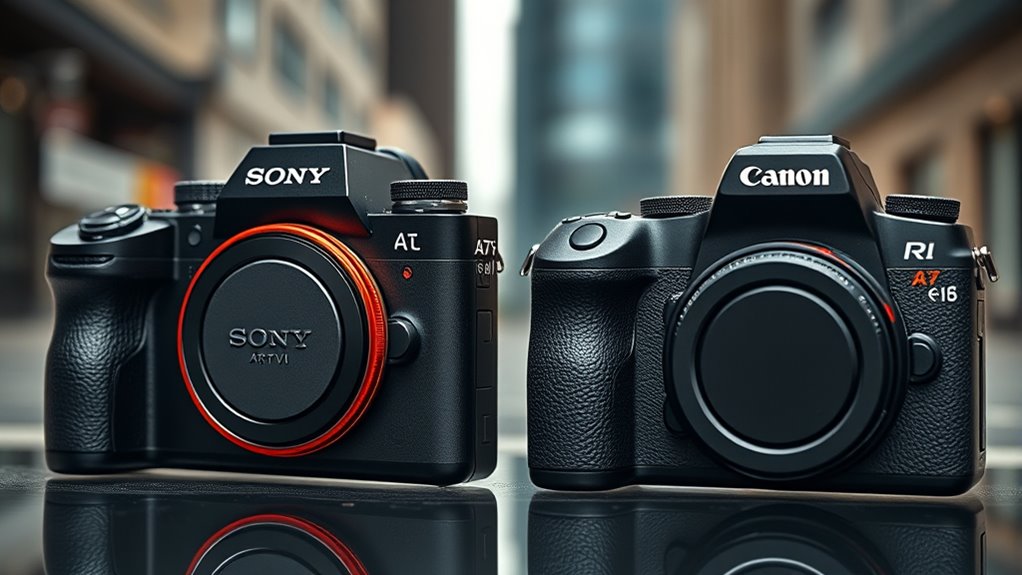
The autofocus systems and shooting speeds of the Sony A7R V and Canon R5 II considerably influence their suitability for different photography styles. The Canon R5 II offers faster burst shooting at 20 fps with advanced subject tracking, making it ideal for action and wildlife. Sony’s 7 fps suits static or portrait work better, prioritizing resolution over speed. Canon’s autofocus excels in dynamic environments with broader sensitivity down to -8 EV, ensuring reliable focus in low light. Sony’s autofocus, optimized for still subjects, performs well in portrait and static scenes. Additionally, the autofocus points and low-light capabilities are key factors in their performance. Here’s a comparison:
| Feature | Sony A7R V | Canon R5 II |
|---|---|---|
| Autofocus Points | 693 | 5,850 |
| Burst Speed | 7 fps | 20 fps |
| Low-Light Autofocus | -3 EV | -8 EV |
Furthermore, the low-light autofocus capabilities of the Canon R5 II give it an advantage in challenging lighting conditions, making it suitable for a wider range of environments. An understanding of shooting speed also plays a crucial role in selecting the right camera for specific genres of photography.
Video Recording Capabilities and Features
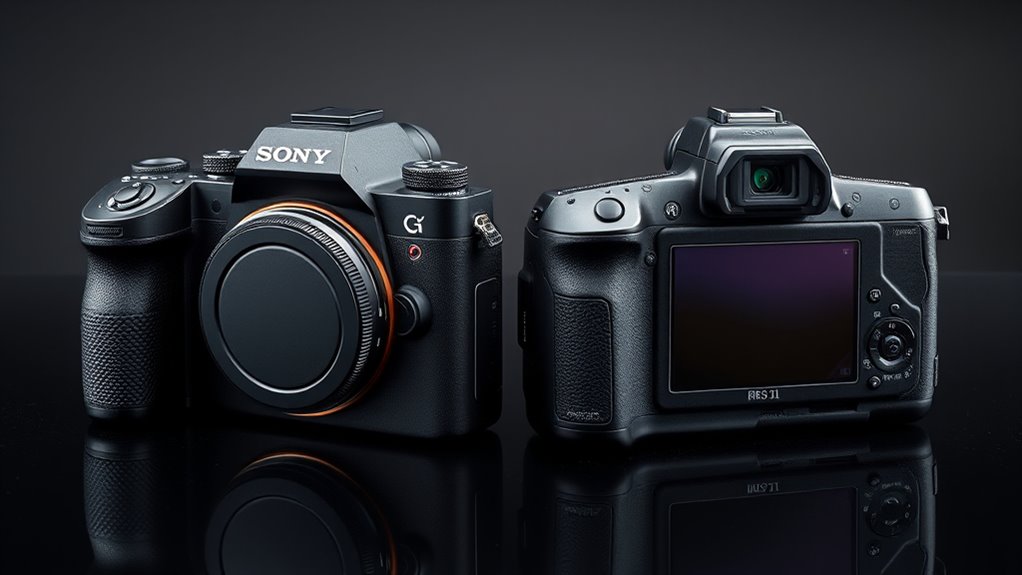
Both the Sony A7R V and Canon R5 II excel in delivering high-quality video recording, but they differ particularly in their capabilities and formats. The Canon R5 II supports 8K DCI at 60 fps, 4K up to 120 fps, and 1080p at 240 fps for slow motion, with 8K RAW recording at 60 fps. Meanwhile, the Sony A7R V offers 8K at 24 fps, 4K UHD up to 60 fps, and 1080p at 120 fps. Canon’s formats include Cinema RAW Light and XF-AVC, providing greater flexibility for post-production. Both support internal 10-bit 4:2:2 recording and HDR profiles like HDR PQ and S-Log3/HLG. Canon’s advanced downsampling yields cleaner 4K footage, while Sony’s simpler compression balances quality and file size. External outputs and stabilization features also enhance video workflows on both cameras. Additionally, understanding video recording formats is crucial for optimizing footage quality and post-processing options.
Image Stabilization and ISO Performance
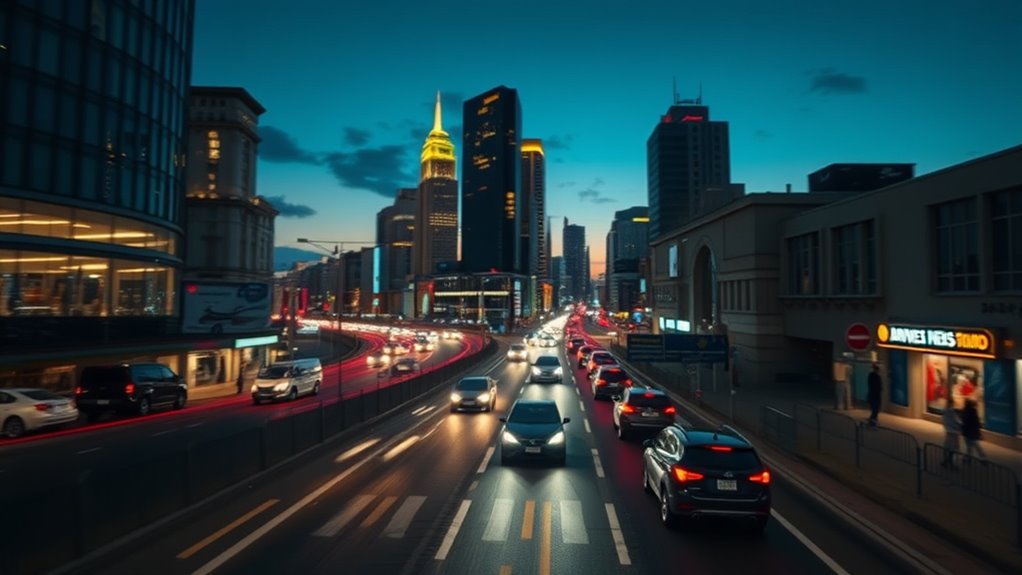
Both cameras excel in image stabilization, but the Canon R5 II’s 8.5 stops offer more steadiness for handheld shots. When it comes to high ISO performance, Canon’s noise reduction may give you cleaner images in low light, even at higher sensitivities. Understanding how their stabilization and ISO capabilities work together can help you choose the best camera for your shooting style. Additionally, considering how Vetted stabilization systems integrate with advanced stabilization techniques can further enhance your handheld shooting experience with either camera, ensuring sharp images even in challenging conditions and allowing photographers to maximize the benefits of both image stabilization systems. Moreover, understanding the adjustable settings for ISO and stabilization can help you optimize performance based on your shooting environment.
Stabilization Effectiveness Comparison
When comparing stabilization effectiveness between the Sony A7R V and Canon R5 Mark II, it’s clear that both cameras feature advanced 5-axis in-body image stabilization systems designed to minimize shake and improve handheld shooting. The Canon R5 II offers slightly better shake compensation, with up to 8.5 stops, compared to Sony’s 8 stops, translating into marginally steadier footage and sharper images in challenging conditions. Both systems work well with stabilized lenses, enhancing overall stability across photo and video modes. Canon’s stabilization excels in fast-paced environments like aerial or climbing shots, while Sony’s system performs strongly but can struggle with rolling shutter artifacts during rapid motion. Overall, Canon’s stabilization provides a slight edge in both reliability and smoothness during dynamic shooting scenarios.
High ISO Noise Levels
High ISO performance plays a crucial role in low-light shooting, and understanding how each camera handles noise can considerably impact your results. The Canon R5 II’s ISO range of 100-51200 (expandable to 50-102400) produces low, manageable noise up to ISO 3200, but noise becomes detrimental beyond ISO 6400. Sony A7R V, with its 61MP sensor, handles high ISO better, maintaining detail and natural appearance even at ISO 6400. Keep in mind:
- Canon’s noise reduction is baked in, softening details but reducing visible noise.
- Sony offers cleaner RAW files, allowing more flexible post-processing.
- Higher resolution on Sony can increase pixel-level noise but benefits cropping and resizing.
- Noise becomes more apparent in Canon images at ISO 6400+.
- Sony’s sensor design delivers superior high ISO dynamic range and noise control.
Your choice affects image clarity in challenging lighting.
Low-Light Shooting Ease
Effective low-light shooting depends heavily on image stabilization and ISO performance, which work together to help you capture sharp images in challenging conditions. The Sony A7r Vi offers a 5-axis IBIS system with up to 5.5 stops of shake compensation, ensuring steady shots even at slow shutter speeds. Meanwhile, the Canon R5 II also features a 5-axis IBIS and adds about 8 stops of stabilization when combined with RF lenses, providing stronger shake reduction. Both cameras support high ISO ranges—Sony from 32,000 up to 102,400, and Canon from 100 to 102,400—allowing flexibility in low-light environments. Their advanced sensors and stabilization systems make handheld shooting in dim conditions more reliable, giving you clear, sharp images without a tripod. Sound design techniques such as image stabilization can be complemented by digital tools to further enhance low-light image clarity. Incorporating mindfulness techniques, such as deep breathing or visualization, can also help photographers maintain focus and patience during challenging shooting conditions.
Design, Usability, and Display Features

When comparing the design, usability, and display features of the Sony A7R V and Canon R5 II, you’ll notice differences in ergonomics and control layouts that affect handling. Both cameras offer articulating screens, but Sony’s flexible articulation provides more versatile shooting angles, while Canon’s interface emphasizes intuitive operation. These design choices directly influence your comfort and efficiency during extended shoots. Additionally, understanding all water parks can be helpful when planning family vacations around photography sessions or outdoor shoots. Recognizing how dream symbols like water or animals might influence your creative inspiration can also enhance your photographic storytelling.
Screen Articulation Flexibility
The design of a camera’s screen articulation directly impacts how easily you can shoot from various angles and in different environments. The Canon R5 II offers a fully articulating (vari-angle) LCD, perfect for vlogging, selfies, and high or low-angle shots. In contrast, the Sony A7R V features a tilting screen that tilts up and down but doesn’t swing to the side, limiting some angles but offering more durability. Body awareness is essential when choosing a screen type, as it influences how comfortably and safely you can maneuver the camera during shoots.
- Fully articulating screens enhance versatility for selfie and vlog shooting
- Tilting screens are more compact and less prone to damage
- Articulating screens simplify composing from difficult angles
- Sony’s design offers better robustness and smoother operation
- Canon’s hinges can sometimes feel loose or awkward over time
Ergonomics and Controls
Ergonomics and controls play a crucial role in how comfortably and efficiently you can operate your camera, especially during long shoots or complex setups. The Canon R5 Mark II offers a larger, more ergonomic grip, making it easier for those with bigger hands to handle extended sessions without fatigue. Its sturdy, weather-sealed magnesium alloy body feels substantial and reliable, though some find the port covers less secure. The high-resolution OLED EVF provides excellent clarity, with Canon’s eye sensor reducing delays. The control layout includes well-placed joysticks and intuitive buttons, but setup for quick ISO changes may take extra steps. In contrast, Sony’s smaller body favors portability, with highly customizable buttons and a responsive touch interface, ideal for users seeking flexibility and quick adjustments.
Market Position and Price Considerations
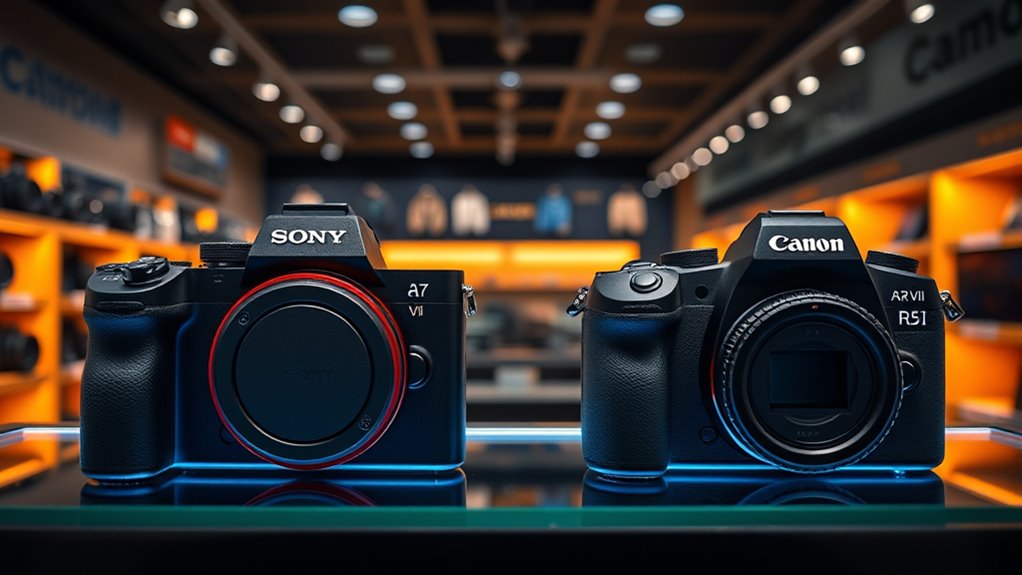
Price plays a pivotal role in shaping the market position of the Sony A7r Vi and Canon R5 II, as both target high-end users but differ in their value propositions. Sony’s $3,898 price makes it attractive for those prioritizing ultra-high resolution and a broad lens ecosystem. In contrast, Canon’s $4,299 launch price reflects its focus on hybrid capabilities, advanced video, and ergonomic design, appealing to professionals needing versatility. Both compete in the premium full-frame mirrorless segment, targeting users who demand top-tier image quality.
Price differences highlight Sony’s resolution focus versus Canon’s hybrid and video enhancements in the premium mirrorless market.
- Sony offers a slight price advantage for resolution-focused users
- Canon’s higher price emphasizes video and ergonomic refinements
- Tight pricing among high-res cameras shows fierce competition
- Resale value remains strong for both brands
- Market perception favors Sony in high-res, Canon in hybrid performance
Which Camera Offers the Best Overall Performance?
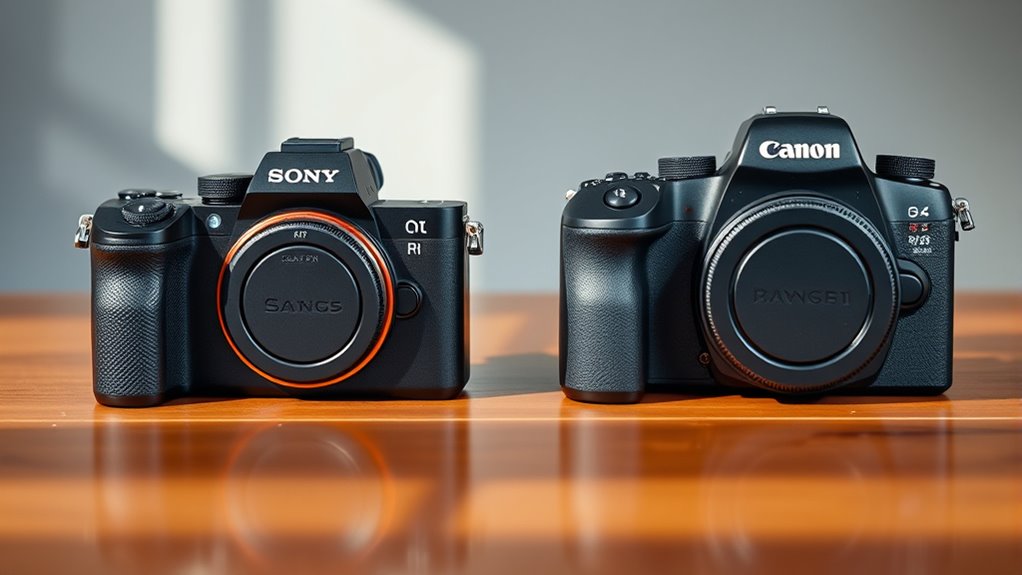
Deciding which camera offers the best overall performance depends on your specific needs, as both the Sony A7R Vi and Canon R5 II excel in different areas. If you prioritize ultra-high resolution images and superior dynamic range, the Sony A7R Vi’s 61MP sensor is a clear advantage, especially for large prints and cropping. However, if fast autofocus, high burst speeds, and advanced subject tracking are more important, the Canon R5 II’s 5,850 AF points and 20 fps shooting make it ideal for action and wildlife. For video, Canon’s 8K capabilities and longer recording durations give it an edge. Meanwhile, Sony’s longer battery life and lighter design benefit extended shoots and portability. Ultimately, your choice hinges on whether resolution, speed, or video features matter most to your work.
Frequently Asked Questions
How Does Battery Life Compare Between Sony A7R Vi and Canon R5 II?
You’ll find the Sony A7R V’s battery life markedly better than the Canon R5 II’s, especially using the viewfinder. Sony’s NP-FZ100 supports roughly 440 to 530 shots per charge, nearly double Canon’s 250 to 340 shots. On the rear LCD, both perform similarly, but Sony still edges out slightly. Overall, Sony’s longer battery endurance means fewer charges and more shooting time during extended shoots.
Which Camera Is Better for Astrophotography and Long Exposure Shots?
They say “the devil is in the details,” and when choosing a camera for astrophotography and long exposures, that rings true. You’ll find the Sony A7R V excels with its 15-minute bulb mode and high-resolution sensor, capturing intricate star fields. Meanwhile, the Canon R5 Mark II’s longer exposure capabilities and excellent noise control make it a strong contender. Both cameras serve well, so your choice depends on your specific needs for detail and exposure length.
Are There Significant Differences in Weather Sealing and Durability?
You’ll notice that both cameras feature weather sealing and durable builds, making them suitable for outdoor use. The Canon R5 II has a proven reputation for ruggedness in extreme conditions like rain and dust, while the Sony A7R IV and V offer solid sealing but may be slightly less tested in harsh environments. Overall, Canon’s sealing tends to be more robust, but both are reliable choices for challenging weather.
How User-Friendly Are the Menus and Customization Options?
You’ll find the menu and customization options vary in user-friendliness. The Canon R5 II offers a cleaner, simpler menu layout, making quick adjustments easier, especially for beginners or those who prefer straightforward controls. Sony’s menus are highly customizable, with more buttons and recall functions, but this can feel overwhelming at first. If you value quick access and minimal complexity, Canon’s interface suits you better, while Sony caters to those who want deep personalization.
Which Camera Offers Better Value for Professional Videographers?
Imagine capturing a wedding in stunning 8K detail, knowing your camera handles long shoots without overheating. You crave professional-grade video features, like RAW output and high-speed recording. You find that the Canon R5 II offers better value, with superior autofocus, no recording limits, and a richer ecosystem of lenses and accessories. Its advanced stabilization and extended battery life ensure smooth, uninterrupted shoots, making it the smarter choice for serious videographers.
Conclusion
Ultimately, choosing between the Sony A7R VI and Canon R5 II is like selecting the perfect lens for your creative journey. The Sony’s sharp, detailed images paint a vivid canvas, while the Canon’s fluid autofocus and robust video capabilities carve out a different path. Think of your style and needs—whispering through the lens or capturing motion in crisp clarity—and let that guide your choice. Whichever you pick, your vision will come alive in stunning detail.

